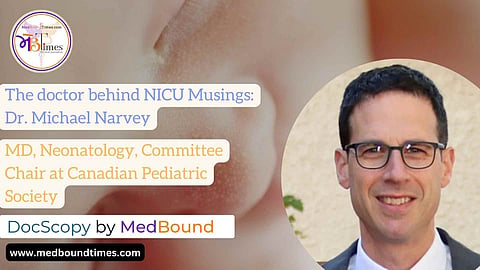The Doctor Behind NICU Musings: Dr. Michael Narvey (Part-2)
Parul Soni: What is your role in the transportation of neonates in the Winnipeg Region of Canada?
Dr. Michael Narvey:
In the Winnipeg Region, I am the Neonatal Transport Associate. I am in charge of ensuring the quality of care for our transported neonates as well as moving our transport team to a new paradigm of care. In addition, I am in charge of overseeing the medical transport program for children aged 0 to 17. As a Medical Director, I train nurses and doctors to effectively handle high-risk patients. High-risk patients (neonates who are under 750 grams) are given care immediately, and there is an expert or physician who can operate CPAP and other devices.
Parul Soni: What is your role as the Medical director?
Dr. Michael Narvey: I provide education, training, and feedback. I provide education to parents, my team, and young professionals. NICU training is an important part of my job. I also serve as a liaison between colleagues who are physicians and doctors in my center when we transport neonates.
Parul Soni: How many preterm cases do you get in your region? What challenges do you face with the less viable fetuses?
Dr. Michael Narvey:
It is hard to give you a number. We see neonates who are born with less viability, maybe five in a year. In the country, there are 50 cases per year. Challenges include resuscitating a baby and the chances of failure. Even though we are doing our best, we are learning new things every day. We are picking up subtle nuances that suggest maybe we could have handled this case better.
Every time we are resuscitating a baby we are gaining experience.
Dr. Michael Narvey, neonatologist.
Sir, you mentioned CQI (continuous quality improvement). Kindly elaborate.
Dr. Michael Narvey: It is the buzzword these days. Continuous quality improvement (CQI) has become an essential component of infant medicine. The application of fundamental principles like robust measurement, repeated modest tests of change, and collaborative learning through data sharing has resulted in improvements in care quality, safety, and outcomes in the Neonatal Intensive Care Unit (NICU). High-risk infant follow-up programs (HRIF) have historically assisted such quality improvement efforts by providing outcomes data on NICU therapies.
Parul Soni: Do people have to wait for months to avail themselves of medical services in Canada?
Dr. Michael Narvey: Every person in Canada is entitled to medical care. We do pay high taxes. In the United States, healthcare is predominantly insurance-based. When you have a private system to get healthcare, it is easy to get health care. If you have money, you can get MRI or CT the next day or whenever needed. In Canada, we have the same services. But in Canada, we have a system to determine who needs it quicker. Unfortunately, every system has a drawback. These things get highlighted easily, but not the great services that the country provides.
Sir, what is the ratio of nurses and physicians in Canada?
Dr. Michael Narvey: We normally have one nurse per patient in the NICU. The nurses work eight to twelve-hour shifts and never leave the baby alone. However, there are fewer physicians. We have four neonatologists on staff.


